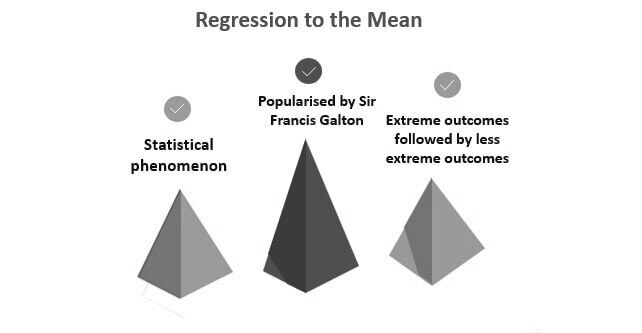Introduction
In the realm of decision-making, the human mind is often influenced by various cognitive biases and heuristics that can lead to suboptimal choices. One such bias, known as “Regression to the Mean,” holds a significant place in our daily lives and decision-making processes. Derived from statistical analysis, this mental model describes the tendency for extreme outcomes to move towards the average over time. Understanding the concept of Regression to the Mean is crucial for making informed decisions, as it helps us avoid irrational judgments and fosters a more objective perspective.
Defining Regression to the Mean
Regression to the Mean is a statistical concept that explains the tendency for extreme values to gravitate towards the average in subsequent measurements. In other words, when an initial measurement is exceptionally high or low, the subsequent measurement is likely to be closer to the average, regardless of the underlying factors influencing the phenomenon. This phenomenon is not limited to statistical analyses; it is deeply rooted in human psychology and affects decision-making processes in various contexts.
The Anchoring Effect
The prevalence of Regression to the Mean can be understood through the anchoring effect, a cognitive bias that leads individuals to rely too heavily on an initial piece of information when making subsequent judgments. This bias often leads people to make irrational decisions by overestimating the significance of extreme or outlier events, assuming they will persist in the future. By recognizing and understanding the anchoring effect, we can gain insights into how Regression to the Mean influences our choices.
Examples Demonstrating the Occurrence of Regression to the Mean:
- Personal Life Decisions: Consider a student who scores exceptionally well on a standardized test. The Regression to the Mean effect suggests that their subsequent test scores are likely to be lower, approaching the average performance of their peers. If the student attributes their initial success solely to their abilities, they may become disheartened and make erroneous conclusions about their academic capabilities.
- Business Scenarios: In the realm of business, Regression to the Mean can mislead decision-makers when evaluating the performance of employees. Suppose a salesperson achieves outstanding results in a particular period. If their subsequent performance falls short of these extraordinary levels, it does not necessarily indicate a decline in competence. Instead, it may simply reflect the natural tendency for performance to move towards the average over time.
- Public Policy-Making: Public policies that are developed based on extreme situations or outliers may fail to yield the desired outcomes. For instance, if a city experiences a significant decrease in crime rates during a specific period, policymakers might attribute it to a particular intervention and implement that approach extensively. However, Regression to the Mean suggests that crime rates are likely to return closer to the historical average, potentially leading to ineffective policy decisions.
Psychological Underpinnings and Biases Contributing to Regression to the Mean: Several cognitive biases contribute to the occurrence of Regression to the Mean. Primarily, confirmation bias leads individuals to selectively search for or interpret information that aligns with their preconceived notions. This bias can reinforce the belief that extreme events will persist, leading to irrational decision-making. Additionally, availability heuristic, which involves relying on readily available examples when making judgments, can perpetuate the Regression to the Mean fallacy.
Identifying and Avoiding the Regression to the Mean Trap
To avoid falling into the Regression to the Mean trap, it is essential to cultivate awareness and adopt more objective decision-making strategies. Here are a few practical tips:
- Understand Statistical Principles: Familiarize yourself with statistical concepts, such as Regression to the Mean, to develop a solid foundation for decision-making. This knowledge will enable you to recognize the phenomenon in various scenarios.
- Gather Sufficient Data: Make sure to gather a significant amount of data and consider trends over time rather than focusing solely on extreme outcomes. By taking a broader perspective, you can better evaluate the likelihood of regression towards the mean.
- Consider Multiple Factors: When making judgments or decisions, consider multiple factors that influence the outcome. This approach helps you avoid fixating on extreme values and encourages a more comprehensive assessment.
- Embrace Long-Term Thinking: Instead of making snap judgments based on isolated events, adopt a long-term perspective. Recognize that extreme outcomes are often temporary and are likely to normalize over time.
Conclusion
Regression to the Mean is a powerful mental model that affects our decision-making processes in numerous aspects of life. By understanding this phenomenon, we can recognize when our judgment is influenced by extreme events and avoid making irrational decisions. By acknowledging the psychological biases that contribute to Regression to the Mean and employing practical strategies, we can foster more objective decision-making and improve our ability to navigate complex choices. Awareness and active avoidance of this mental trap are essential for making sound judgments and achieving better outcomes in both personal and professional spheres.
